As happy as I was to salvage the half point in my fourth round game, I was still pretty down about missing that fork. I decided a nice meal would cheer me up. So I hopped on the Metro and went into DC, to have dinner at one of my favorite restaurants, Tono Sushi, conveniently located across the street from the Woodley Park stop on the red line.
It worked! I felt much better, shrugged off my three bad games in a row and showed up for round five ready for a fight.
But it was not to be. Fifteen minutes after go time my opponent was nowhere to be found. The rules say that you get an hour to show up before you can be forfeited, but I called it to the attention of one of the tournament directors anyway. After a little poking around, it turned out an error had occurred. You see, players have the option of requesting a bye for one or more rounds. Sometimes, for whatever reason, you want to play in the tournament but there's one round you can't make it too. Well, it turns out that my opponent had requested a bye for this round, meaning he should not have received a pairing. Due to a computer error this bye did not get recorded. So the bottom line was that my opponent was not penalized in any way, but the result was scored as a win by forfeit for me.
On to round six! I was white this time. I had just made my twelfth move:

You are looking at a very famous position from one of the main lines of the Dragon Sicilian. The Dragon is another of these openings that has always existed at the periphery of master practice. It has periodically been dismissed as simply unsound for black, but it always seems to make a comeback. Heck, Magnus Carlsen used to play it often in his youth, and Gary Kasparov whipped it out, successfully, as a surprise weapon against Anand in their World Championship match. On the other hand, Bobby Fischer was openly disdainful of it.
Anyway, in the position above, 12. ... e5 is by far the most popular move. After 13. Bc5 Be6 we are led into some of the most complex waters in opening theory. No, black did not overlook his hanging rook on f8. He's just salivating over the tremendous attack he will get if white is foolish enough to take it. I had studied these lines pretty carefully in preparation for the tournament, but my opponent chose a different approach. He went for 12. ... Bxd4. This seems counter-intuitive, since black is giving up his prized bishop, but it is actually quite playable. Alas, I had never seen this move before, so I was on my own. After 13. Qxd4 Qb6 14. Nxd5 cxd5, white has a choice to make. After the game I looked up the line in Edward Dearing's book on the Dragon. It seems that all the cool kids are playing 15. Na4. However, I preferred to steer the game into the calm waters of a double rook endgame and played 15. Qxb6 axb6 16. Kb1 e6 17. Bb5 Ba6 18. Bxa6 Rxa6, leading to this position:
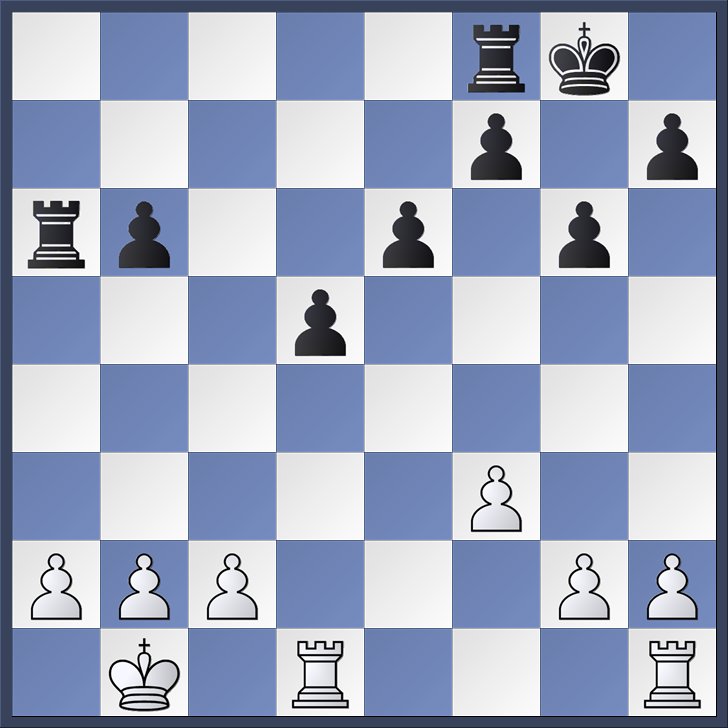
That's quite a change from the last diagram! Now, objectively this ending is just completely level. Black has a strong center to compensate for his weak b-pawn, but with decent play there's no reason to think either side can make progress. But I was feeling pretty optimistic. I happen to like dry endgames. Relative to other players with my rating, I think I play endgames a bit better, and chaotic tactical situations a bit worse. The previous three games illustrated that quite nicely.
My confidence was raised over the next few moves: 19. Rd4 Rb8 20. c4 dxc4 21. Rxc4 Ra7 22. Rhc1:

White has made real progress over the last three moves. He has chipped away at black's center, created a fast two vs one pawn majority, and brought both of his rooks into play. In the same interval black has not done much of anything. He could, and should, have stopped my c4 move by playing b5, but instead he was being a bit listless. I think white can now claim to be better, though objectively the position is still very drawish.
But black's next move is just an error. He played 22. ... Kf8, and received a rude awakening after 23. Rc8+ Rxc8 24. Rxc8+ Ke7 25. Rb8:
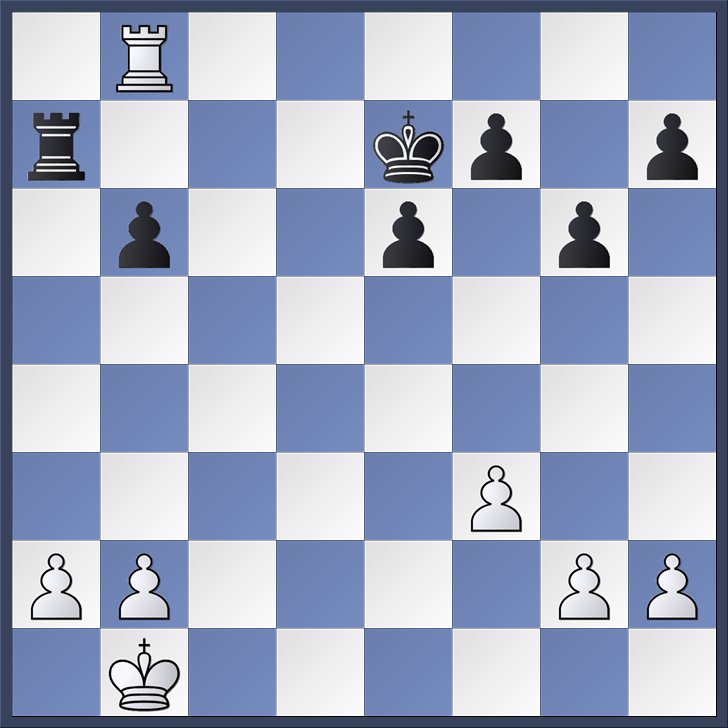
You can kiss black's b-pawn good-bye. What is black to do? The only way he can protect the pawn is with 25. ... Ra6. But white will then play 26. Rb7+, which prevents the black king from coming to the queenside by threatening the kingside pawns. White will then play b4 and b5 to drive the black rook away. So that doesn't work out too well for him.
So black went for his only other option. The first thing you learn about rook endings is that keeping your rook active is worth a pawn or two. So play continued 25. ... Rd7 26. Rxb6 Rd2. I was actually very happy to see this last move, since I think black is now just dead lost. During the game I was more concerned about 26. ... Rd1+ 27. Kc2 Rg1, and the computer confirms that this was a better defense. White would still be better, but there is work to do.
But after black's actual move the basic battle is clear. White is going to storm his a-pawn down the board. Black is going to gobble some kingside pawns and then race his rook back to the a-file. Can black get his rook back in time? Let's find out!
Play continued 27. a4 Rxg2 28. a5 Rxh2 29. a6 Rh5:
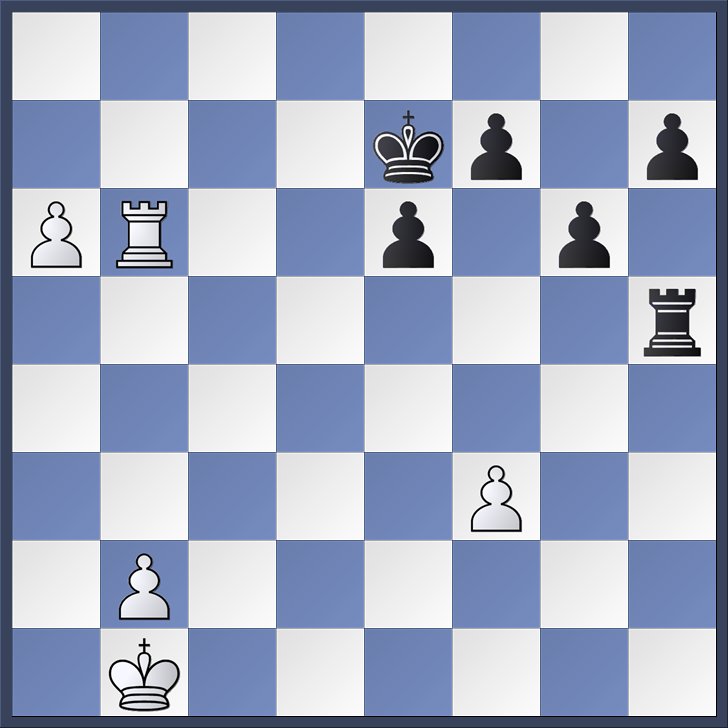
Black makes his first try. If white advances his pawn to a7, then black will reply with Ra5. But white stymies this plan with 30. b4, which protects the a5 square.
So black switches to plan B: 30. ... Rh1+ 31. Kb2 Rh2+ 32. Kb3 Rh3 33. a7 Rxf3+ 34. Ka4 Rf1:
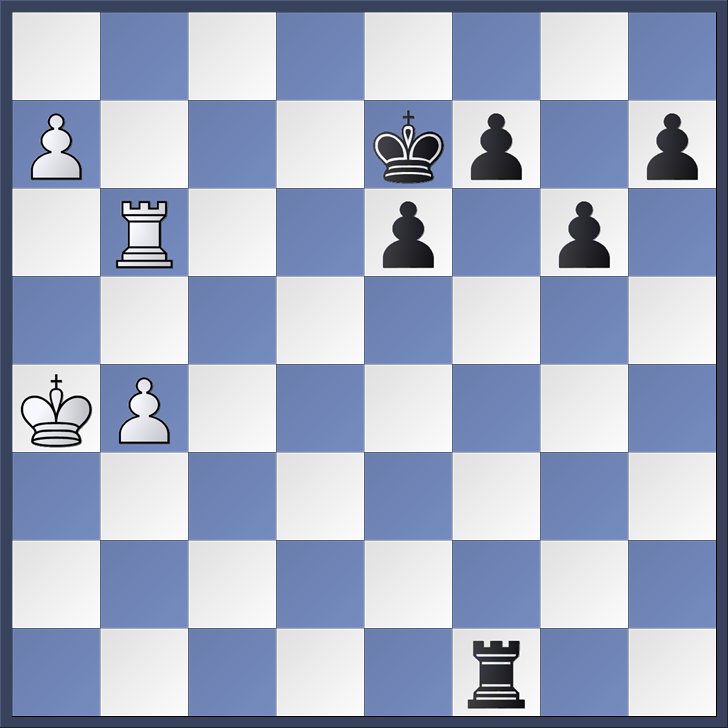
Now the idea is that if white promotes, black plays the skewer 35. ... Ra1+. When the white king moves out of the way, the white queen on a8 gets took! Happily, I was on it. I played 35. Ra6, after which there is no plan C.
This moment was especially gratifying for me. You see, I had reached this position in my mental analysis back when I played 23. Rc8+. Tournament chess provides many frustrations. You play twenty perfect moves and then blow it with one careless blunder. You mess up in the opening and find yourself playing grim defense for the next three hours. Your opponent hasn't bathed in a while. But there are also moments of glory. Like when you calculate a long line and then see it play out, just as you calculated it, on the board. (Of course, sometimes the line plays out the way you calculated it but your assessment turns out to be wrong, but we won't swell on that.)
Let's see the big finale: 35. ... h5 36. a8Q h4:
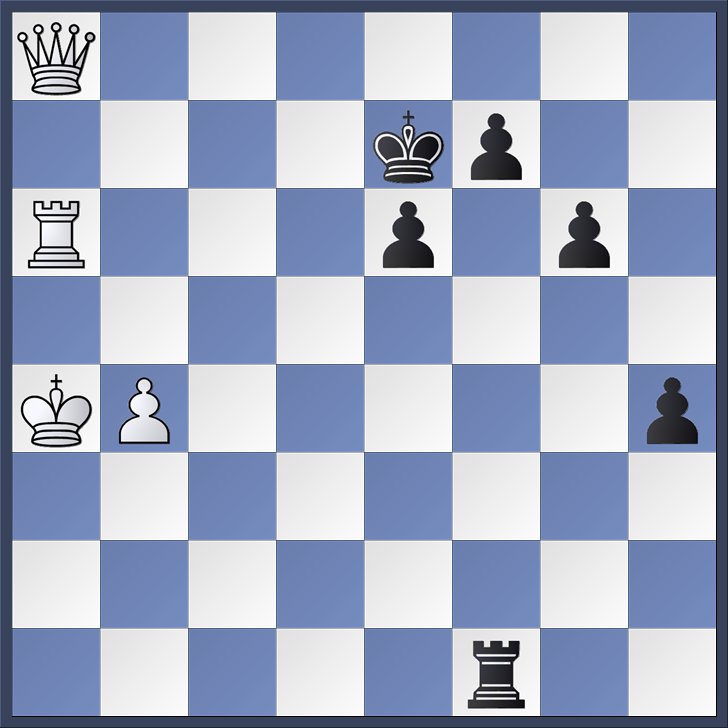
Of course, white is just completely winning. Still, four connected passed pawns, supported by a king and a rook, are nothing to sneeze at. In such positions it's worth investing a few minutes to find the cleanest kill. I finished things off with the pretty, corner-to-corner move 37. Qh8. The point is that I don't want the black king escaping to f6, where it might find shelter amidst the rook and pawns. The computer observes that after this move, white has forced mate in twelve. The final moves were 37. ... Rf4 38. Ra7+ Kd6 and the skewer 39. Qb8+ finished things off:

Once the black king moves out of the way white will take the rook on f4. Then we will be playing the queen versus pawns game, except that black only has half his pawns and white has an extra rook.
After that win I was back on track! And just check out what happened in round seven:
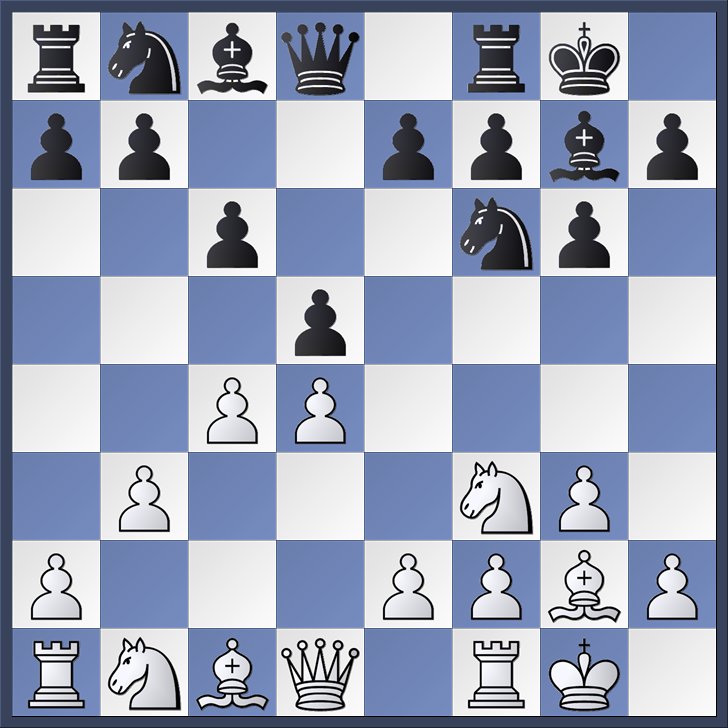
I was black, and I was about to make my seventh move. In my last post I mentioned that I had worked out a new opening repertoire for this tournament. For queen pawn openings I had decided on the Semi-Slav Defense. When the game opened with 1. d4 d5 2. c4 c6 3. Nf3 Nf6 I thought I would get to show off what I had learned. But then white fianchettoed his king bishop, and I replied in kind. At this point I think the position is technically a line from the Grunfeld Defense. Anyway, white just moved his pawn to b3. I replied with 7. ... c5, which seemed like a good way of taking advantage of white's weak long diagonal. The computer likes this idea, but suggests that it would have been even stronger if I had traded pawns on c4 first. I'm not sure why.
Anyway, the game plodded along for a while. We were mostly just shuffling the pieces around. Here's the position after white's twentieth move:
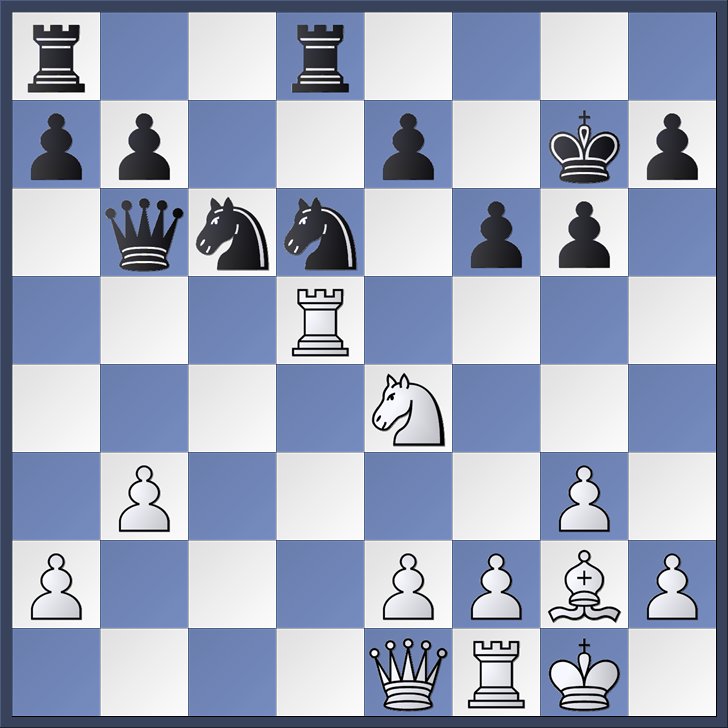
The opening has worked out rather well for black. His development is more harmonious than white's, and white's queenside pawns are vulnerable. But white's last move, moving his knight from d2 to e4, is just a clear error. After the natural sequence 20. ... Nxe4 21. Bxe4 Rxd5 22. Bxd5 Nb4, black's fork will net him a pawn. But white thought he had a way around this. Play continued: 20. ... Nxe4 21. Rxd8:
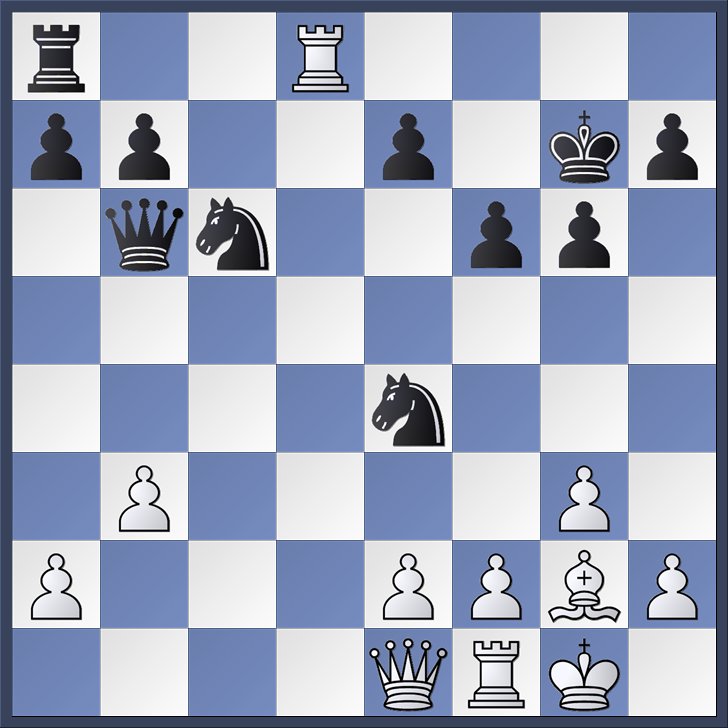
White's idea is that if black plays the automatic recapture 21. Rxd8, then white captures the knight on e4, rather than d5, and now there's no fork.
But hasn't white missed something? Since I don't always miss tactical shots I played 21. ... Nxf2!. Now, at this point white should bail out with something like 22. Qxf2 Qxf2+ 23. Kxf2 Rxd8. He is down a pawn, sure, and can look forward to a long defense. But it will not be easy for black to win, even with the extra pawn.
My opponent was having none of it, though. He went in for the queen versus two rooks endgame with 22. Rxa8 Nd3+ 23. Kh1 Nxe1 24. Rxe1 Qf2:
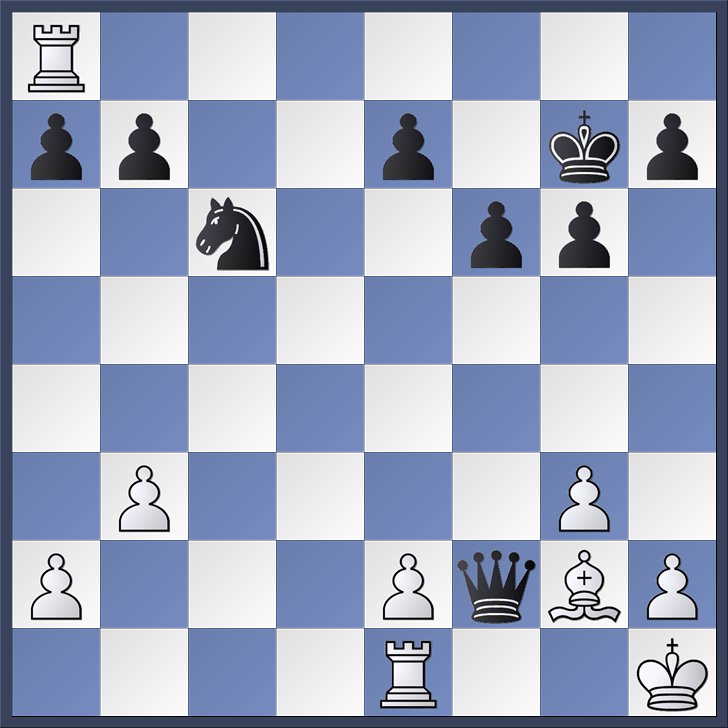
Now, queen versus two rooks can be a tricky thing to assess. If the rooks are cooperating, then they are often stronger than the queen. In the present situation, though, I was pretty optimistic. Black's queen is so strong, and white's king so weak, that it is effectively impossible for white to bring his e1 rook into the game. That rook is needed to protect the first rank. Moreover, black has the makings of an effective attack on the king, since his knight and h-pawn quickly arrive on menacing squares.
Skipping ahead a few moves we see the plan playing out to perfection:
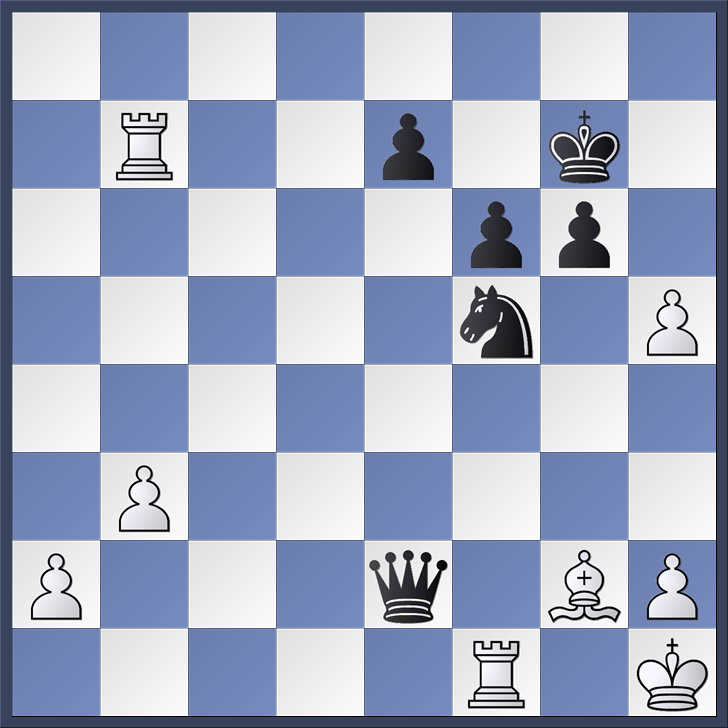
Black now has a clean kill with 30. ... Nh4. Black is threatening mate on g2, and what is white to do? Moving the bishop along the long diagonal hangs the rook on f1. Playing Bh3 just allows the fork with Qe4+, snagging the b7 rook. The only other option is 31. Rg1, but this allows the combination 31. ... Nxg2 32. Rxg2 Qf1+ 33. Rg1 Qf3+:
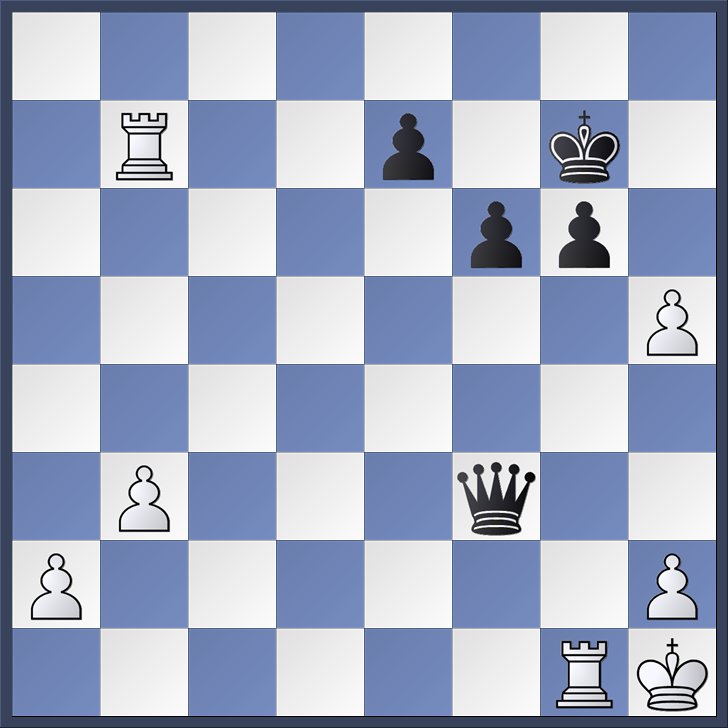
which again snags the b7 rook.
The rest is just a mopping up operation. White chose to lose a rook on his own terms, and play continued: 31. Rxe7+ Qxe7 32. hxg6 Nxg2 33. Kxg2 Kxg6.

At first blush you might think that black still has some work to do. White has a rook and two connected passed pawns in exchange for the queen, after all. Actually, though, this is just an easy win for black. The queenside pawns are way too far back to be threatening. If white tries to advance them they will just be picked off with forks. Meanwhile, black will march his king, queen and pawn up the board, in formation, until white simply runs out of moves. That happens with surprising rapidity: 34. Rf3 f5 35. a4 Qe2+ 36. Kg3 Qe5+ 37. Rf4:
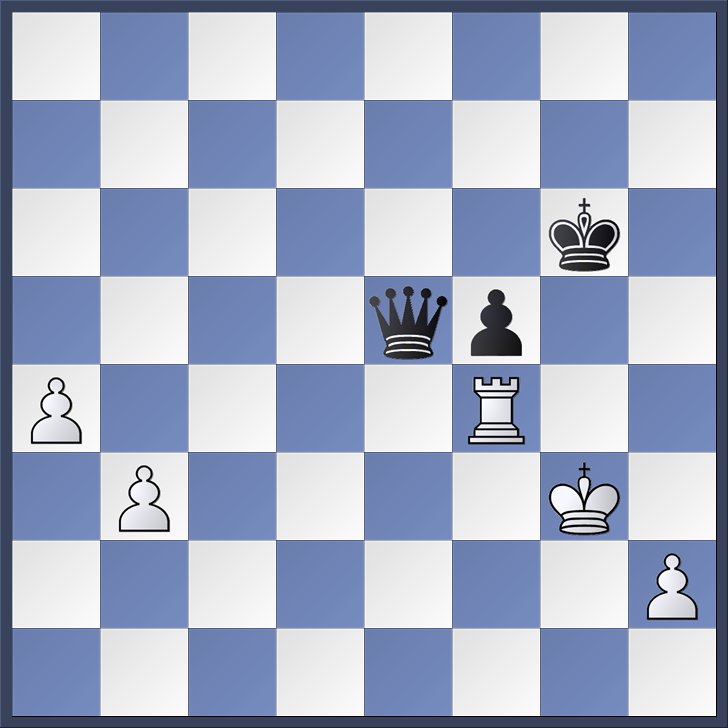
And white is already dead in the water. The game concluded with 37. ... Qe3+ 38. Rf3 Qg1+ 39. Qg4 mate:

Of course, white could have prolonged the game with 38. Kf4, but after 38. ... Kf6 it will only be a few more moves before the white king and rook are driven apart.
So, that was two wins in a row! Yay me! Suddenly I was liking chess again. Out of six games played I now had three wins, two losses and one draw. But there was still one more day to go, and what happened in round eight puts everything else to shame...

Hey, Jason, great to see you back in action! As you figured, I was instantly wondering where the Scandinavian had got to...
From the look of things, I don't think you've got THAT much rust to shed. (I find myself missing opponent's tactical shots much, much more frequently than I ever used to). That's a very nice "Spielmann tip", btw.
As far as opening preps, I never found that it mattered as much in the under-2000 world. Over 2000, it does a quantum leap. I myself dallied a bit with the Semi-Slav but I honestly found It just overwhelming trying to play it against stronger players who knew all the subtle-looking moves that lead to time-consuming difficulties for Black 6 moves later.
Really looking forward to Round 8!
The most important thing for ELO 2000- players like BMcN, JR and me is not proving an opening advantage, but getting positions around move 12 that make you feel comfortable.
So my question to JR is: if you're relatively weak at tactics, how good are you at preventing tactics - ie profylactic chess? Most players like us prefer to grab the initiative, to overwhelm the opponent and kill him off in a direct attack. But there are some other strategies, equally deadly in the right hands. One of them is focused at denying the opponent all counterplay, evt. simplifying directly to a nice endgame and if that is not possible to build up gradually until the opponent doesn't have any good move left. How does that sound, JR? If good I can give you some ideas.
Bill--
Good to hear from you! I think some amount of opening preparation is unavoidable. For example, I mentioned that I played the Giucco Piano. In preparing that, I spent a lot of time looking at the Evans Gambit. If someone springs that on you, you're not going to be able to figure out what to do at the board. Same thing with the Yugoslav Attack. So I do think it's valuable to spend some time on openings, even though you're right that sub-2000 no one really knows how to play middlegames anyway. Opening preparation is a lot easier than it used to be, with computers to help you refute gambits and with engaging openings books that are organized around whole games.
Er, what's a Spielmann tip?
MNb--
I think my opening preparation worked out pretty well, since in eight games I was never worse out of the opening. On the other hand, I should probably give some thought to things like the Reti or the English, instead of my usual 1. e4. The trouble is that even while I'm not always so good in tactical positions, I still enjoy playing them!
"my opening preparation worked out pretty well"
As this is worth nothing if you mishandle the subsequent middle game this was not my point.
"while I’m not always so good in tactical positions, I still enjoy playing them!"
But for us amateurs this is a relevant point indeed. Then I only can repeat my suggestion: do lots and lots of tactical exercises. If you google "chess tactics exercises online" you'll find more sites then you ever will be able to digest.
Jason -- the "Spielmann tip" was a reference to MNb's "hat tip" from your first post. And, of course, if you're changing openings that's when you do need to look at a variety of possibilities in depth. Particularly if you're going the 1.e4 e5 route; that's a rather large ocean. Good luck as you continue to sail on it!